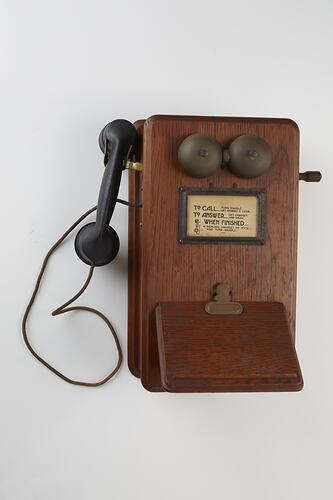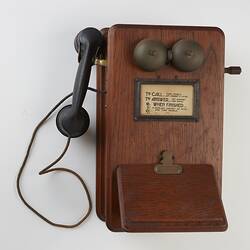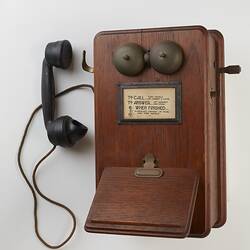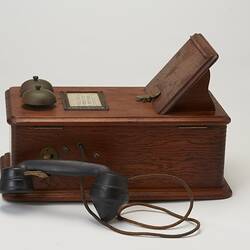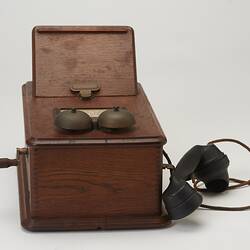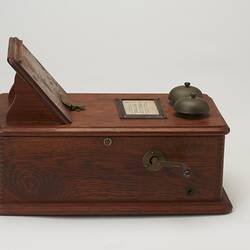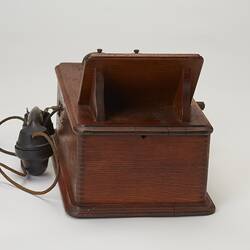Summary
British Ericsson Party Line wall telephone.
This phone was owned by Pam Robinson, a fine wool farmer and vocal advocate for landcare, environment, local government and women in agriculture.
The phone was used at 'The Elms', Baddaginnie, from the 1930s to 1971. The phone number was 2D and is known as an Australian Post Office Type 235MWH. The phone was upgraded with a handset, and the original transmitter holes were covered over by the "How To Call" notice. This phone was typical of the refurbished models that were in the Warrenbayne, Baddaginnie and other farming districts of the time throughout Victoria. The phone was in use until 1971 when Pam and David upgraded to a dial tone unit. The phone then became an ornamental piece in the house and Pam's subsequent homes until she moved to South Melbourne in 2016.
This is a party-line phone and was a critical tool to maintain connections with the local community. In a time when people didn't travel as often, the phone was often the only link to the wider world. It was used for important social conversations, to place grocery orders in time for them to come out with the next mail run, to organise local response to bushfires or other emergencies, to manage peak periods of work on local farms (harvest or shearing). The party-line linked to a local exchange operator could also be called on for 'remote baby sitting', where the exchange operator would ring children home alone to make sure we were behaving themselves. The exchange operator was also in a good position to provide intelligence on the wanderings of children on their return home from school.
When she married in February 1969, Pam and her husband David moved into the house on the Robinson family farm, 'The Elms', which was located in the foothills of the Strathbogie Ranges, near Baddaginnie. Pam was the fourth and last Mrs Robinson to live at The Elms. The house had no electricity, but it had a phone. When the option to be connected to electricity came through the district in the late 1950s, David's uncle decided that it was an unnecessary extra, whereas the phone was always considered an important tool in farming.
Pam Robinson has many achievements. She received the Medal of the Order of Australia in the Queen's Birthday Australian Honours in 1990 for Services to Local Government and her pioneering work in land conservation and environment. She was an early grower of coloured wool, pioneered community action by local farmers to address environmental degradation that predated Landcare, and was an active community organiser. Pam was also a vocal advocate for farmers, including speaking as a farmer about Premier Kennett's industrial relations proposals at the Victorian farmers' march in Shepparton in 1992.
Pam Robinson was also actively involved in the Australia Rural Women's Movement, and was described as "one of today's new breed of young women who dare to question accepted practices and traditions...[and who hopes] that the career of farmer may soon become a readily acceptable option for a woman who loves the land...'to get a better deal for women in agriculture'" (Doreen Carswell,1982). In an article for 'The Land' in 1996, Pam talked about the the struggle for women to claim the right to participate in decisions impacting the farm and their lives, and the gendered nature of the farm in previous generations, and in regards to her in-laws, Pam said: 'Everything within the garden fence was Alice's. Everything outside was Stan's'. Pam was also interviewed as a woman in agriculture for the ABC TV program "Countrywide" in 1982.
Pam was the manager of 'The Elms' farm enterprise. Pam and her husband David lived there from 1969 until David's death in 1999. Their son Daniel also lived at the farm from 1976 until Pam sold it in 2000, having transitioned from farming to work within local government and environmental consulting.
Physical Description
Varnished wooden box with a plastic hand receiver on a metal hook on the left hand side. A pair of brass metal bells are mounted on the front with rectangular glass panel below, and a wooden writing slope at the base with a metal clip for paper. Metal winding handle on the right hand side. Inside wooden box (hinged on left hand side) there are electrical wires and components with empty space on lower half. There is a hole on the back top for hanging and three plastic feet.
Significance
This item is one of a collection that represent Pam Robinson's farm work and achievements during the1980s. It supports the Invisible Farmer ARC project and Museum Victoria's Invisible Farmer Collection by giving form to the many ways in which women are involved in agriculture, including their leadership and innovations in agriculture, community development and environmental sustainability. This collection supports the key aim of the Invisible Farmer project - to redress the absence of rural women in mainstream histories and museums, and reinterpret material culture and histories by documenting the untold stories of women on the land.
More Information
-
Collection Names
-
Collecting Areas
-
Manufacturer
-
Place & Date Used
-
Inscriptions
Front panel: To CALL...TURN HANDLE / LIFT HANDSET & LISTEN. / To ANSWER...LIFT HANDSET / AND SPEAK. / WHEN FINISHED... / [Arrow] REPLACE HANDSET ON HOOK / AND TURN HANDLE. / . On back in ink: AC 207
-
Classification
-
Category
-
Discipline
-
Type of item
-
Object Dimensions
350 mm (Width), 260 mm (Depth), 416 mm (Height)
Width measurement including handset on craddle and winder. Width of wooden box only: 250mm; Length of cord: 830mm
-
References
[Link 1] Website viewed 11.8.2017 [Link 2] Website viewed 11.8.17 <[Link 3]>, viewed 18 July 2018.
-
Keywords
Communication Equipment, Telephones, Rural Life, Rural Women, Farmers, Farms, Domestic Technology, Communities, Environmental Protection, Sustainability, Sustainable Agriculture
